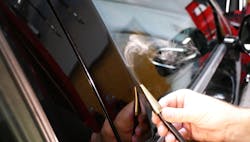Cabin air leaks are more than just a noisy annoyance to the operator of a vehicle; a leaking seam around the edges of the windshield is hazardous and a potential catalyst for further maintenance issues. The ability to accurately detect the location of a leak is critical in ensuring no damage to electrical systems arises via unwanted entry of moisture into the cab of a vehicle.
What could go wrong?
Notice of a leaking windshield will usually reach the maintenance department by way of a driver telling someone they can hear air hissing into the cab as they are driving. However, there is more to be concerned with than the driver’s discomfort.
The dashboard in today’s commercial vehicle is full of electrical components and connections. With the dashboard being the immediate point of contact behind the windshield, these electrical systems are susceptible to damage should a leak be present around the windshield.
A leak can allow more than just air into the cab – particularly water. Water making its way into the dashboard, and subsequently contacting any electrical components, can wreak havoc on various systems.
The use of electronic logging devices (ELDs) was congressionally mandated for commercial vehicle drivers logging their hours of service through the Federal Motor Carrier Safety Administration (FMCSA), as part of the Moving Ahead for Progress in the 21st Century Act (MAP-21). Enforcement for this mandate took effect in December of 2019. Even if not required by mandate due to an exemption, many fleets have opted to install ELDs – typically on the dash and in close proximity to the windshield.
As with many electronic devices, a vehicle’s ELD is also susceptible to water damage. Should a windshield with a leaking seam allow moisture to come into contact with an ELD, the result could be far more costly than merely replacing the device. This is just one example of critical electrical components in the cab that are susceptible to damage by way of a leaking windshield.
Other examples of susceptible equipment include any windshield-mounted devices such as cameras, radar, or GPS systems. Any and all electrical connections on the dash and around the windshield have the potential to cause problems beyond damage, such as operational failure and safety issues. In some extreme cases, an air leak may allow exhaust fumes to leak into the cab of the vehicle.
Seal the deal
“Windshields are a big problem; they’ve always been a big problem with the gluing aspect,” says Hawkins.
A replaced windshield that was not properly installed, dried glue or rubber along the seam on an older vehicle, or even body damage that was never properly addressed could all be causes of a cabin air leak. Whatever the case may be, the leak needs to be addressed sooner rather than later.
Though it may not seem like an issue that could take a vehicle out of commission, there is a constant risk of further damage should a leak remain unsealed.
Cabin leak detection
Though a driver can usually hear a cabin air leak, they can rarely pinpoint the leak’s precise location. Technicians acknowledge that the detection process for pinpointing a leak from the windshield can be tedious. As a result, technicians have become innovative, as the tools used to accurately spot such a leak are not designed to do so as their primary application.
A maintenance facility most likely already has a smoke machine on-site for diagnosing intake and exhaust system leaks or, if servicing light duty vehicles, finding evaporative emission control (EVAP) system leaks. A smoke machine can also help detect cabin wind and water leaks.
Mark Hawkins, manager, technical products, at Redline Detection, explains how fleets can perform a simple procedure to accurately detect a leak at the seam of a windshield. Redline Detection is a manufacturer of professional diagnostic leak detection equipment.
Hawkins first recommends turning the key to the “on” position, without turning the engine on. Then, a technician would turn on the dashboard air vent to the high setting to allow fresh air to enter the cab. Next, to create a sealed environment, roll up the windows and close the doors. “What that does is provide a positive pressure inside the cab,” Hawkins says.
To search for a leak, a technician would then walk around the outside of the vehicle with the smoke machine, blowing smoke along any area where a leak may be suspected – including along edges and seams.
With the cabin’s positive pressure and a smoke machine, leaks can be detected fairly quickly by noticing a deflection of the smoke as it is passing along the seams of the windshield.
“The positive pressure forces air out of the cab at [the location of the leak] and it and deflects the smoke in the opposite direction that it is flowing out of the smoke hose,” Hawkins says.
Detecting cabin leaks should be done at a low pressure.
“You’re going be inside when you do this [procedure]; if you’re outside, forget it,” says Chuck Abbot, vice president, global automotive, CPS Products. CPS Products designs and manufactures tools, instruments, and service equipment to deliver leak detection technologies. “If there is any wind, it will cause a disruption in the smoke pattern. And you certainly don’t want to be standing next to a blowing fan [during this procedure]. So, it does require being in a rather still area.”
Abbott also suggests utilizing a diffuser on the smoke hose.
“If you don’t diffuse the smoke, it is coming out rather rapidly, and it’s hard to disturb a rapid movement of smoke,” Abbott says. He advises that with a rapid movement of smoke, a technician would be unable to see a disruption in the smoke pattern at the leak location.
“Use a device that diffuses and slows down the flow of smoke and causes the smoke to basically sit in suspension over the potential leak area. [This allows] you to see the slightest interruption,” he adds.
“It is such a simple, clean procedure, and it keeps the cab completely isolated and clean. You’re not getting any vapor inside of the cab,” says Alex Parker, CMO of Redline Detection. “It’s a very quick procedure that, if used either in repair or PM, gives you 100 percent confidence in being able to find the leak point.”
The team at Redline Detection recommends fitting this procedure into preventive maintenance schedules to stay ahead of moisture intrusion and the maintenance implications should a leak remain undetected and un-serviced.
After the leak point is detected and repaired, performing the detection procedure again establishes a system to “quality control your repair,” Hawkins says.
Utilizing a smoke machine and a pressurized cabin, technicians can quickly, easily, and confidently pinpoint the location of a leak at the seam of the windshield, seal the leak, and keep the vehicle up and running.
About the Author
Tyler Fussner
Associate Editor | Fleet Maintenance
Tyler Fussner is Managing Editor - Community Manager at Supply Chain Connect, part of the Design & Engineering Group at Endeavor Business Media.
Previously, Fussner served as the Associate Editor for Fleet Maintenance magazine. As part of Endeavor's Commercial Vehicle Group, his work has been published in FleetOwner magazine, as well as Bulk Transporter, Refrigerated Transporter, and Trailer-Body Builders.
Fussner's May 2022 print feature 'The dawn of hydrogen trucks' was named the best single technology article in B2B by the judges of the 2022 Folio: Eddie and Ozzie Awards. Fussner was also awarded Silver in the Technical Article category for the Trade Association Business Publications International (TABPI) 2021 Tabbie Awards.
Fussner previously served as Assistant Editor for Endeavor's Transportation Group on the PTEN, Professional Distributor, and VehicleServicePros.com brands.
Fussner studied professional writing and publishing at the University of Wisconsin-Whitewater. He has experience in shop operations, is a Michelin Certified Tire Technician, and a Michelin Certified Tire Salesperson.

